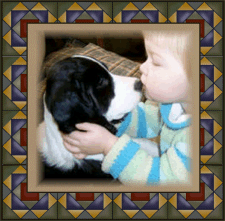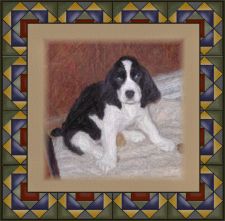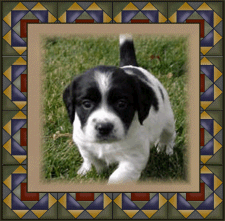|
English Springer Spaniel
Heath
 |
|
Canine
Hip Dysplasia
Hip
dysplasia is a developmental abnormality of the hip joints
caused by laxity within the joint. Changes in bone size, shape
and structure occur as the hips attempt to compensate for
abnormal stresses on the joints. Dogs with hip dysplasia may
exhibit lameness at some time in their lives. By the time
affected dogs are two years of age, hip dysplasia is detectable
by x-raying the hips.
Young dogs (3 to 12 months of age) with hip dysplasia may be
afflicted with acute inflammatory joint pain. Spontaneous
temporary improvement usually occurs between 6 and 12 months.
Older dogs (1.5 to 10 years of age) with hip dysplasia may have
a slow onset of painful arthritis.
Treatment for young dogs is often unnecessary. For the older
dog, medications can be used to reduce the arthritic pain.
Surgical procedures are also available to limit pain and
reconstruct the hip joint.
Your puppy's chances of developing hip dysplasia are minimized
if both parents have normal hips. Ask for documentation to
affirm that the sire and dam have had hip x-rays that have been
appropriately evaluated. Accepted methods of evaluation are
certification of normal hips by the Orthopedic Foundation for
Animals (OFA), which is indicated on your dog's official
American Kennel Club pedigree after the registered names of
his/her predecessors. Hip evaluations by board-certified
veterinary radiologists also provide acceptable evidence of
conscientious efforts by the breeder.
For additional information, visit the
OFA
Orthopedic Foundation for Animals website.
You can also
search this database by dog's registered name and breed.
 |
| Hereditary
Eye Disorders
The eyes of
English Springer Spaniels are susceptible to a number of
genetic-based disorders, some of which are present at birth and
others that may develop at various times throughout life.
Retinal Dysplasia (RD)
RD is a developmental malformation of the retina.
Affected puppies are born with the disorder. Most cases are
mild; small folds and areas of retinal degeneration occur on the
surface of the retina with no detectable loss in vision. These
abnormalities are diagnosed by certified veterinary
ophthalmologists when puppies are 7 to 12 weeks old. Retinal
dysplasia should not affect a dog's ability to function as a
pet; however, affected Springers should not be bred.
Progressive
Retinal Atrophy (PRA)
PRA is a degeneration of the layers
of the retina that are responsible for vision. The disease is
progressive, eventually resulting in blindness. The onset in
Springers is variable, but usually occurs between 2 and 6 years
of age. The disorder is still considered rare; however, its
incidence has increased in recent years. There is no pain or
discomfort for the dog but, unfortunately, there is no
treatment.

Responsible breeders pay close attention to the eyes of their
breeding stock throughout the dogs' lives, monitoring puppies
and adults for the development of hereditary eye disorders.
Annual examination of the eyes by a diplomate of the American
College of Veterinary Ophthalmologists is recommended for all
breeding stock. Ask your dog's breeder for proof that an ACVO
examination has been conducted on the sire and dam of your puppy
within the last year, and ask for proof that the puppy's eyes
have been examined.
Eyes that are normal -- free from hereditary
disorders -- may be certified annually by the Canine
Eye Registry Foundation (CERF). If the puppy's
parents are normal, the puppy's chances of developing eye
disorders are significantly reduced.
Eyelid defects
occasionally occur. Entropion is an inward folding of the lower
eyelid that results in chronic irritation of the surface of the
eye. It is usually observed within the first year of life.
Entropion can be surgically corrected.
|
|
Aggressive or Timid
Temperament:
Temperament and
behavior problems happen in all breeds of dogs. Behavior is
influenced by many factors, not only genetics but also training,
family interactions, and general health. A puppy should be
curious and playful, without resisting being held. He should not
be aggressive or overly timid. Make every effort to ensure that
your puppy comes from breeding stock with good, solid
temperaments. Meet both parents and related dogs, if possible,
and spend enough time with them to be comfortable with their
personalities. Ask your breeder if he/she is aware of any
temperament problems in your puppy's pedigree. As your puppy
grows, nurture him with proper training. Neuter your puppy to
minimize the effect that sex hormones have on undesirable
behavior. If your puppy or dog exhibits signs of behavioral
problems, notify the breeder immediately and seek the help of a
qualified professional. Click here
to read the article about aggression, by Lyn Johnson,
DVM.

|
|
Seizure Disorders:
Hereditary seizures are
relatively rare in English Springer Spaniels. A familial pattern
to the disorder exists in many pedigree lines, and some cases of
seizures in English Springers are not controlled with treatment.
Seizures usually begin before the age of five years. In many
cases, seizures can be controlled with medication. You should
ask your puppy's breeder for full and complete disclosure of any
seizure disorders within your puppy's pedigree.
|
|
Skin Disorders:
Typical signs of skin disease
include scaliness, greasiness, itching, pyoderma (infection),
and occasional hair loss. There are genetic as well as other
factors involved in the development of skin diseases.
Seborrhea may be local, or may occur over large parts of the
body. It usually results in scaly, thickened, itchy skin with a
greasy feel and an associated odor. Secondary skin infections
are not unusual. Treatment may include medicated baths, topical
medications, and antibiotics.
Allergies occur in all breeds of dogs. Canine allergies usually
cause symptoms in the skin. The primary symptom is itching, but
seborrhea, skin infections and hair loss are also common.
Inhaled pollens or house dust, certain types of food, flea bites
and other materials can trigger allergic reactions in the skin.
Symptoms may be seasonal. While there is no cure for allergies,
treatment may involve eliminating contact with the offending
allergen (a diet change, for example, if the allergy is to a
food substance), treating to relieve itching and other symptoms,
and allergy testing and injections.
|
|
Ear Infections:
Ear
infections are common in English Springer
Spaniels due to their pendulous ear flap, which decreases air
circulation within the ear canal. The resulting environment
contributes to bacterial and yeast infections. Most can be
prevented with an ear care program that keeps the ears clean and
dry. There are several very good ear care products available
from your veterinarian. All Springers should get regular ear
care. Acute and chronic infections should be treated by your
veterinarian.
|
|
Bloat (Gastric dilation or gastric torsion):
Bloat
results from a build-up of gas or fluid in the stomach. This
condition can be life-threatening, so if you suspect your dog is
suffering from bloat you should consult a veterinarian
immediately. Some breeds of dog, particularly larger, deep-chested
breeds, are suspected of having genetic susceptibility to bloat.
At this time, no evidence suggests that this is the case in the
ESS. For additional information on current research in this
area, refer to Purdue University's Center for the Human-Animal
Bond Canine
Gastric Dilatation-Volvulus (Bloat) Research Section
Bloat: First Aid for aka Gastric Dilatation-Volvulus
Syndrome (GDV), prepared by Siefried Zahn D.V.M; Adapted from
"Bloat in Large Dogs"; Published by Univelt, Inc.
1983; (ISBN 0-912183-00-4)
Bloat
Research Program & Bloat Notes Newsletter and Recent
Findings Purdue University, School of Veterinary
Medicine
|
|
For
more information about Canine Health Issues go to the Health
Links Page

|
|